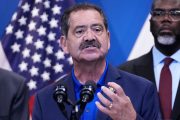Liberal media bias has long been an open secret. But now it’s so bad that even a liberal mainstream newspaper notes that, in an effort to destroy Donald Trump, the media have jumped the shark.
In a Los Angeles Times piece, columnist Justin Raimondo writes that to “fight Trump, journalists have dispensed with objectivity”; he then asks, “Why are the rules of journalism being rewritten this election year?” He also theorizes that the pro-Hillary Clinton bias has become so blatant it may actually backfire on the media.
As his first example, Raimondo cites how the media present out of context Trump’s statement that the Russians should release Clinton’s 30,000 “lost” e-mails, portraying an obvious joke as dangerous encouragement of foreign espionage. On this count Raimondo makes a good point, though: If the e-mails are all “personal,” as Clinton has maintained, how could they threaten national security?
Nonetheless, the media casts Trump as “a kind of Manchurian candidate,” as Raimondo puts it, “in what was once called red-baiting.” Yet this smacks of projection. Consider that former Bill Clinton political hit man Larry Nichols revealed in 2015 that the first time he met Hillary, she was wearing a medal around her neck stating, “Proud member of the American Communist Party” (video here; forward to 6:07). Also note, the Clinton Foundation has received millions of dollars from Russian sources, and many allege that these monies essentially were bribes in exchange for access to American technological secrets and for a huge portion of the United States’ uranium stockpile. This, not to mention that our country is in many respects now more “red” than Russia — largely due to the machinations of Clinton and her fellow travelers.
Even more strikingly, the media have engaged in outright collusion with Democrat operatives. As Raimondo reports:
DNC emails, published by Wikileaks, reveal a stunning level of collaboration between important media outlets and the Democrats. Former DNC Chairwoman Debbie Wasserman Schultz sought to silence NBC’s Mika Brzezinski, who had found fault with the DNC’s role in the primaries. The emails have headings like “This must stop.” Incredibly, NBC’s Chuck Todd agreed to act as a go-between, even arranging a call between Wasserman Schultz and Brzezinski. Which raises the question: Why was a major media figure taking his marching orders from the Democratic party chair — and how did this affect his network’s coverage of the Trump campaign?
The DNC emails also show that Politico reporter Kenneth Vogel sent his copy for a story on Clinton’s fundraising operation to the DNC’s national press secretary, Mark Paustenbach, prior to publication. Politico has since apologized, but Vogel has his defenders. The Washington Post’s Erik Wemple said Vogel’s “prepublication generosity” was meant to give “the people you’re writing about … the opportunity to rebut all relevant claims in a story.” One wonders if the Washington Post does this for the Trump campaign. Somehow I doubt it.
Yet it must be pointed out that, contrary to Raimondo’s assertion, media rules aren’t being rewritten; written long ago, they’re just more devoutly embraced with each succeeding media degeneration. For example:
• In 2004, famed newsman Dan Rather’s career was ended when it was discovered that he had peddled forged documents purporting to show that President George W. Bush had shirked his Texas Air National Guard duties in the 1960s and 1970s.
• In 2010, there was the JournoList Scandal, involving an online meeting place in which journalists would conspire to slant the news; this proved that not all media bias was unintentional.
• The media happily reported the claim that WWII-era pontiff Pius XII was “Hitler’s Pope.” Yet they just as happily ignored an even bigger story: the 2007 revelation that the allegation was a malicious fabrication promoted by a Soviet disinformation campaign.
• While the media can’t let go of the Catholic Church sex scandal, they ignore the child sex abuse in government schools, a phenomenon a federally funded study found was 100 times the magnitude of the church scandal. In fact, the researchers evaluated a certain time period and discovered that California’s 61 biggest newspapers ran 2,000 stories about the church scandal but only four about the school scandal.
• The media gratuitously report stories of police shootings of black criminal suspects, despite these occurrences having declined 75 percent during the last few decades. Yet while the police not only shoot more whites but, according to studies, are actually more likely to do so, such events are never widely publicized. This lends the illusion that blacks are under assault, creates racial unrest, and has led to the “retaliatory” murder of cops.
• In 2012, NBC heavily doctored George Zimmerman’s 911 call in a manner many describe as malicious, as it did a cut-and-paste job that made him appear bigoted.
The above is, of course, just a short list. In addition, there’s also the “everyday” bias, such as calling statist politicians with anti-immigration policies (e.g., France’s Marine Le Pen) “right-wing” while refusing to call socialists such as Francois Hollande left-wing; branding semi-automatic rifles “assault weapons”; and labeling pro-life people “anti-abortion” and pro-abortion people “pro-choice.” And then there’s social-media bias, which is just as profound and which I reported on here and here.
And this bias has a devastating effect. The media are the people’s conduit of information, and how can Americans make the right decisions regarding politicians and policies if they’re given misinformation? As with a computer, it’s garbage in, garbage out.
And what is the nature of the political litterbugs? In his 2011 book Left Turn, UCLA political science professor Tim Groseclose quotes “a well-known poll in which Washington correspondents declared that they vote Democratic 93 percent to 7 percent,” writes U.S. News. The site continues:
As a result, he says, most reporters write with a liberal filter. “Using objective, social-scientific methods, the filtering prevents us from seeing the world as it actually is. Instead, we see only a distorted version of it. It is as if we see the world through a glass — a glass that magnifies the facts that liberals want us to see and shrinks the facts that conservatives want us to see.”
He adds: “That bias makes us more liberal, which makes us less able to detect the bias, which allows the media to get away with more bias, which makes us even more liberal.”
And this sways elections. As Groseclose also wrote, “Media bias aids Democratic candidates by about 8 to 10 percentage points in a typical election. I find, for instance, that if media bias didn’t exist, John McCain would have defeated Barack Obama 56 percent to 42 percent [in 2008], instead of losing 53-46.”
I’ve often quipped that the Democrats have the world’s most effective public-relations team: the U.S. media. And what of Raimondo’s theory that their now bare-naked bias may inspire a backlash that elects Trump? Such a phenomenon would likely just diminish, but not completely negate, the Democrat-buttressing effects of media manipulation. With only six percent of Americans approving of the media, though, Trump would be wise to portray himself as the opponent of this fourth estate-cum-fifth column. It’s morally fitting, too, to run against a group that is running against America.




